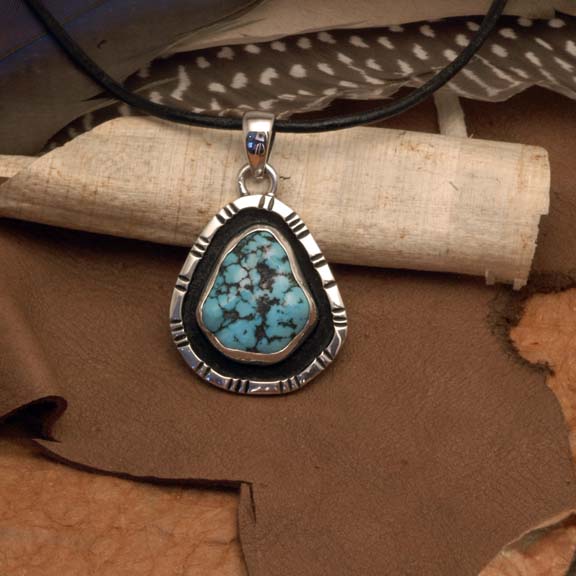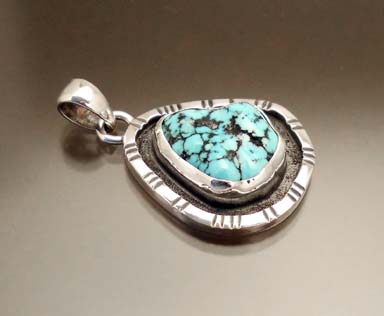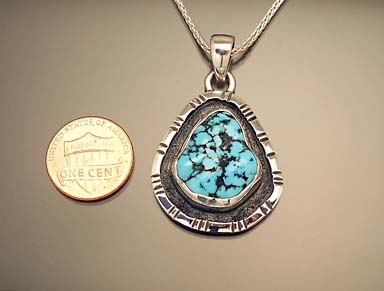Turquoise
and Silver Pendant

American mined Turquoise (probably
Kingman mine) that I bought many years
ago at the now defunct Indian
Jewelers' Supply in Albuquerque, NM.
This is set in a handmade sterling
silver pendant, 1 3/4 inch tall
by 1 1/8 inch wide including the bail.
This piece has a really nice heft and
feel to it.
$300.
Does NOT include chain but they are available HERE

Turquoise
Mention Turquoise, and most people will probably
think of Native American silver jewelry set with the sky blue
gemstone. Turquoise has always been highly venerated in Native
American traditions. It is an essential presence in the
Shaman's medicine bag. It can be a simple nugget or bead, or
it may be carved in the shape of a totem animal, and adorned
with feathers and bits of stone tied to it with sinew. The
Pueblo people often placed Turquoise in the floors of their
dwellings to bring good fortune. Although Turquoise is closely
identified with Native Americans, its lore and appreciation
stretch across the globe.
It was discovered by the ancient Egyptians around
3000 BC and was used widely in their finest jewelry and
ornaments often combined with Lapis Lazuli and Carnelian as in
the treasures of Tutankhamun's tomb. The Turquoise was carved
into scarabs, and representations of the various gods and worn
by the priests for ceremonial purposes. The ceramic Faience
was developed by the Egyptians as an imitation for Turquoise
and Lapis Lazuli.
Old European traditions associate Turquoise with
horses, and hold that the stone will protect horses from all
sorts of ills. In particular, it was said to prevent them from
drinking overly cold water while overheated and foundering.
Turquoise was said to enable its wearer to resist evil and
maintain virtue. It was credited with helping achieve a state
of higher consciousness and resistance to weakness. It was
also thought to protect its wearer from falling, particularly
from towers and horses.

Tibetans revere the stone and believe it represents
good fortune, good health, and that it provides powerful
protection against the evil eye. Turquoise is used in Tibetan
healing ceremonies, where a Turquoise bead is thought to hold
the shadow soul and draw out illness from the body. Buddhists
associate Turquoise with knowledge of the future.
Many Tibetans still wear necklaces with Turquoise,
and coral beads which are hundreds of years old, and Turquoise
often adorns ceremonial objects. In both Tibet and Nepal,
Turquoise is highly esteemed and can also serve as currency.
Today the major sources of Turquoise are Arizona,
plus Australia, Chile, China, and Mexico. The stone often
occurs with veins of matrix which add interest to its beauty.
Body oils can sometimes cause Turquoise to turn green with
time.
Hardness: 5-6
Toughness: Fair to good
Alternate birthstone for December
We accept
credit cards through Paypal, and you don't even need
a Paypal account!

Free shipping on any order
over $100. within the USA
USA: $10. Shipping and handling under $100
CANADA $15.
Shipping and handling most orders , heavier or
bulky items will have additional shipping invoiced
separately
|
|



